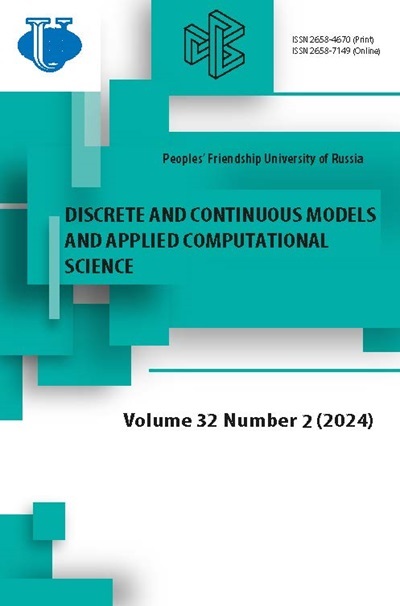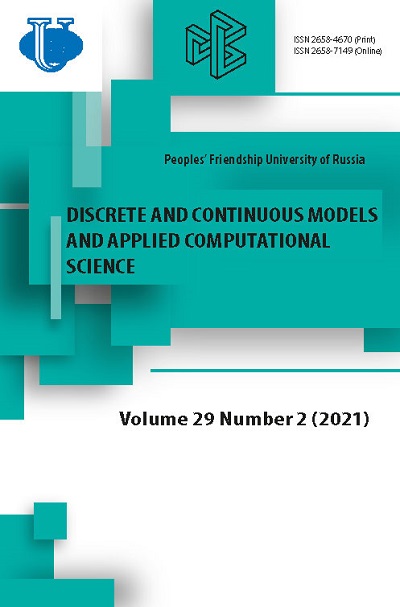Асимптотическое решение сингулярно возмущённой задачи Коши для уравнения Фоккера-Планка
- Авторы: Буатта М.А.1, Васильев С.А.1, Виницкий С.И.1,2
-
Учреждения:
- Российский университет дружбы народов
- Объединённый институт ядерных исследований
- Выпуск: Том 29, № 2 (2021)
- Страницы: 126-145
- Раздел: Статьи
- URL: https://journals.rudn.ru/miph/article/view/26868
- DOI: https://doi.org/10.22363/2658-4670-2021-29-2-126-145
Цитировать
Полный текст
Аннотация
Асимптотические методы - очень важная область прикладной математики. Существует множество современных направлений исследований, в которых используется малый параметр, например статистическая механика, теория химических реакций и др. Использование уравнения Фоккера-Планка с малым параметром очень востребовано, поскольку это уравнение является параболическим дифференциальным уравнением в частных производных, а решения этого уравнения дают функцию плотности вероятности. В работе исследуется сингулярно возмущённая задача Коши для симметричной линейной системы параболических дифференциальных уравнений в частных производных с малым параметром. Мы предполагаем, что эта система является неоднородной системой тихоновского типа с постоянными коэффициентами. Цель исследования - рассмотреть эту задачу Коши, применить асимптотический метод и построить асимптотические разложения решений в виде двухкомпонентного ряда. Таким образом, это разложение имеет регулярную и погранслойную части. Основным результатом данной работы является обоснование асимптотического разложения для решений этой задачи Коши. Наш метод может быть применён для широкого круга сингулярно возмущённых задач Коши для уравнений Фоккера-Планка.
Об авторах
М. А. Буатта
Российский университет дружбы народов
Автор, ответственный за переписку.
Email: adelbouatta.rudn@mail.ru
ORCID iD: 0000-0002-5477-8710
PhD’s degree student of Department of Applied Probability and Informatics
ул. Миклухо-Маклая, д. 6, Москва, 117198, РоссияС. А. Васильев
Российский университет дружбы народов
Email: vasilyev_sa@rudn.ru
ORCID iD: 0000-0003-1562-0256
Candidate of Physical and Mathematical Sciences, Assistant professor of Department of Applied Probability and Informatics
ул. Миклухо-Маклая, д. 6, Москва, 117198, РоссияС. И. Виницкий
Российский университет дружбы народов; Объединённый институт ядерных исследований
Email: vinitsky@theor.jinr.ru
ORCID iD: 0000-0003-3078-0047
Leading researcher of Bogolyubov Laboratory of Theoretical Physics of Joint Institute for Nuclear Research, Professor of Department of Applied Probability and Informatics of Peoples’ Friendship University of Russia (RUDN University)
ул. Миклухо-Маклая, д. 6, Москва, 117198, Россия; ул. Жолио-Кюри, д. 6, Дубна, Московская область, 141980, РоссияСписок литературы
- D. Daniel, W. T. Taitano, and L. Chacon, “A fully implicit, scalable, conservative nonlinear relativistic Fokker-Planck 0D-2P solver for runaway electrons,” Computer Physics Communications, vol. 254, p. 107-361, 2020. doi: 10.1016/j.cpc.2020.107361.
- Y. Ito, “Self-similar orbit-averaged Fokker-Planck equation for isotropic spherical dense star clusters (i) accurate pre-collapse solution,” New Astronomy, vol. 83, p. 101-474, 2021. doi: 10.1016/j.newast.2020.101474.
- P. Jiang, “Global existence and large time behavior of classical solutions to the Euler-Maxwell-Vlasov-Fokker-Planck system,” Journal of Differential Equations, vol. 268, pp. 7715-7740, 12 2020. doi: 10.1016/j.jde.2019.11.085.
- H. P. Le, “Quantum Fokker-Planck modeling of degenerate electrons,” Journal of Computational Physics, vol. 434, p. 110-230, 2021. doi: 10.1016/j.jcp.2021.110230.
- M. A. Malkov, “Propagating Cosmic Rays with exact Solution of Fokker- Planck Equation,” Nuclear and Particle Physics Proceedings, vol. 297-299, pp. 152-157, 2018. doi: 10.1016/j.nuclphysbps.2018.07.023.
- W. T. Taitano, L. Chacon, and A. N. Simakov, “An adaptive, implicit, conservative, 1D-2V multi-species Vlasov-Fokker-Planck multi-scale solver in planar geometry,” Journal of Computational Physics, vol. 365, pp. 173-205, 2018. doi: 10.1016/j.jcp.2018.03.007.
- H. Wang, “Global existence and decay of solutions for soft potentials to the Fokker-Planck-Boltzmann equation without cut-off,” Journal of Mathematical Analysis and Applications, vol. 486, p. 123-947, 2 2020. doi: 10.1016/j.jmaa.2020.123947.
- M. Zanella, “Structure preserving stochastic Galerkin methods for Fokker-Planck equations with background interactions,” Mathematics and Computers in Simulation, vol. 168, pp. 28-47, 2020. doi: 10.1016/j.matcom.2019.07.012.
- H. J. Hwang and J. Kim, “The Vlasov-Poisson-Fokker-Planck equation in an interval with kinetic absorbing boundary conditions,” Stochastic Processes and their Applications, vol. 129, pp. 240-282, 1 2019. doi: 10.1016/j.spa.2018.02.016.
- H. J. Hwang, J. W. Jang, H. Jo, and J. Y. Lee, “Trend to equilibrium for the kinetic Fokker-Planck equation via the neural network approach,” Journal of Computational Physics, vol. 419, p. 109-665, 2020. doi: 10.1016/j.jcp.2020.109665.
- S.-N. Li and B.-Y. Cao, “Anomalous heat diffusion from fractional Fokker-Planck equation,” Journal of Computational Physics, vol. 99, p. 105-992, 2020. doi: 10.1016/j.aml.2019.07.023.
- H. Patel and B. D. Shizgal, “Pseudospectral solutions of the Fokker-Planck equation for Pearson diffusion that yields a Kappa distribution; the associated SUSY Schrodinger equation,” Computational and Theoretical Chemistry, vol. 1194, p. 113-059, 2021. doi: 10.1016/j.comptc.2020.113059.
- L. Philipp and B. D. Shizgal, “A Pseudospectral solution of a bistable Fokker-Planck equation that models protein folding,” Physica A: Statistical Mechanics and its Applications, vol. 522, pp. 158-166, 2019. doi: 10.1016/j.physa.2019.01.146.
- Y. Su and L. Yao, “Hydrodynamic limit for the inhomogeneous incompressible Navier-Stokes/Vlasov-Fokker-Planck equations,” Journal of Differential Equations, vol. 269, pp. 1079-1116, 2 2020. doi: 10.1016/j.jde.2019.12.027.
- A. N. Tikhonov, “The dependence of the solutions of differential equations on a small parameter [O zavisimosti reshenij differencial’nyh uravnenij ot malogo parametra],” Sbornik: Mathematics [Matematicheskii Sbornik], vol. 22 (64), pp. 193-204, 2 1948, in Russian.
- M. I. Vishik and L. A. Lyusternik, “Regular degeneration and boundary layer for linear differential equations with a small parameter multiplying the highest derivatives [Regulyarnoe vyrozhdenie i pogranichnyj sloj dlya linejnyh differencial’nyh uravnenij s malym parametrom],” Russian Mathematical Surveys [Uspekhi matematicheskih nauk], vol. 12, pp. 3-122, 5(77) 1957, in Russian.
- A. B. Vasil’eva, “Asymptotic behaviour of solutions of certain problems for ordinary non-linear differential equations with a small parameter multiplying the highest derivatives [Asimptotika reshenij nekotoryh zadach dlya obyknovennyh nelinejnyh differencial’nyh uravnenij s malym parametrom pri starshih proizvodnyh],” Russian Mathematical Surveys [Uspekhi matematicheskih nauk], vol. 18, pp. 15-86, 3(111) 1963, in Russian.
- S. A. Lomov, “The construction of asymptotic solutions of certain problems with parameters [Postroenie asimptoticheskih reshenij nekotoryh zadach s parametrami],” Mathematics of the USSR-Izvestiyas [Izvestiya Akademii nauk SSSR], vol. 32, pp. 884-913, 4 1968, in Russian. doi: 10.1070/IM1968v002n04ABEH000675.
- V. A. Trenogin, “The development and applications of the asymptotic method of Lyusternik and Vishik [Razvitie i prilozhenie asimptoticheskogo metoda Lyusternika-Vishika],” Russian Mathematical Surveys [Uspekhi matematicheskih nauk], vol. 25, pp. 123-156, 4(154) 1970, in Russian. doi: 10.1070/RM1970v025n04ABEH001262.
- J. L. Lions, “Singular perturbations in boundary problems and optimal control[Perturbations singulieres dans les problems aux limites et al. control optimal],” French, Lecture Notes in Mathematics, vol. 323, pp. 1-645, 1973. doi: 10.1007/BFb0060528.
- O. Hawamdeh and A. Perjan, “Asymptotic expansions for linear symmetric hyperbolic systems with small parameter,” Electronic Journal of Differential Equations, vol. 1999, pp. 1-12, 31 1999.
- A. Perjan, “Linear singular perturbations of hyperbolic-parabolic type,” Buletinul Academiei de Ştiinţe a Republicii Moldova, Matematica, pp. 95-112, 2 2003.
- A. Gorban, “Model reduction in chemical dynamics: slow invariant manifolds, singular perturbations, thermodynamic estimates, and analysis of reaction graph,” Current Opinion in Chemical Engineering, vol. 21, pp. 48-59, 2018. doi: 10.1016/j.coche.2018.02.009.
- C. D. Zan and P. Soravia, “Singular limits of reaction diffusion equations and geometric flows with discontinuous velocity,” Nonlinear Analysis, vol. 200, p. 111-989, 2020. doi: 10.1016/j.na.2020.111989.
















